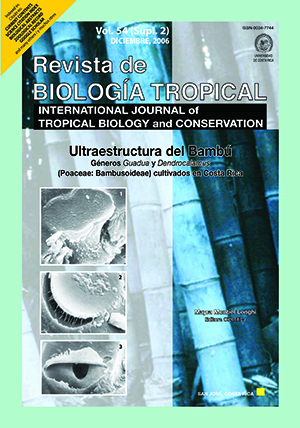Abstract
An ultraestructural analysis of the Taiwan and Thailand clones of Dendrocalamus asper made with the scanning electron microscope showed that the Taiwan clone had low dome stomata while the Thailand clone has high dome stomata in the leaf lamina. Cuticular wax accumulations in the Taiwan clone has two shapes, against four in the Thailand clone. Both have the same distribution of vascular and surrounding tissues. Macroscopic or microscopic observation of culm bracts are not recommended to differentiate these clones: a reliable identification requires observation of the ultrastructure of stomata and cuticular wax accumulations. Rev. Biol. Trop. 54(Suppl. 2): 65-75. Epub 2006 Dec. 01.References
Ghosh, S.S. & B.S. Negi. 1959. Anatomical of Indian bamboo. Part I. Indian For. 86: 719-727.
Grosser, D. & W. Liese. 1971. On the anatomy of Asian bamboos with special reference to their vascular bundles. Wood Sci. Technol. 5: 290-312.
Metcalfe, C.R. 1960. Anatomy of the monocotyledons. I. Gramineae. Oxford Clarendon, Oxford, Inglaterra. 731 p.
Seethalakshmi, K.K. & M.S. Muktesh Kumar. 1998. Bamboos of India: A compendium. Brill, Leiden, Los Países Bajos. 342 p.
Tateoka, T., S. Inoue & S. Kawano. 1959. Notes on some grasses IX: Systematic significance of bicelular microhairs of leaf epidermis. Bot. Gaz. 121: 80-91.
Widjaja, E.A. 1995. Dendrocalamus asper (Schult f.) Backer ex Heyne, p. 80-93. In Dransfield, S. & E.A Widjaja (eds.). Plant Resources of South-East Asia Nº 7. Bamboos. Backhuys, Leiden, Los Paises Bajos. 189 p.
##plugins.facebook.comentarios##

This work is licensed under a Creative Commons Attribution 4.0 International License.
Copyright (c) 2006 Revista de Biología Tropical






